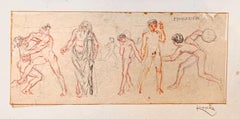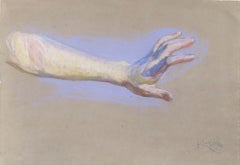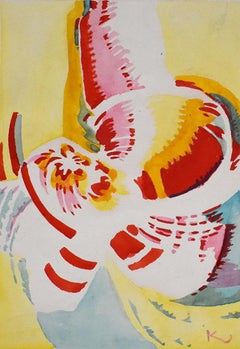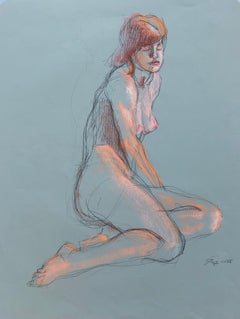Frantisek Kupka Art
to
2
1
2
2
2
2
Overall Height
to
Overall Width
to
1
2
2
1
1
1
1
4
1
1
4
6,909
3,240
2,514
1,217
3
3
2
2
1
Artist: Frantisek Kupka
Gymnasium, circa 1908-1909 colored crayon, pencil, gouache and pen and ink
By Frantisek Kupka
Located in Jerusalem, IL
coloured crayon, pencil, gouache and pen and ink on tracing paper mounted onto the artist's mount
The authenticity of this work has been confirmed by Pierre Brullé.
Category
Early 1900s Frantisek Kupka Art
Materials
Ink, Watercolor, Gouache, Laid Paper, Pen
Arm
By Frantisek Kupka
Located in New York, NY
Pastel on paper
13 x 19 in. (33 x 48.2 cm.)
Signed (at lower right): Kupka
EX COLL.: private collection, St. Louis; to Howard Baer, 1972; [Gimpel-Weitzenhoffer Galleries,
New York...
Category
20th Century Frantisek Kupka Art
Materials
Paper, Pastel
Untitled (Study for a Pochoir) - Abstract Czech Art
By Frantisek Kupka
Located in London, GB
FRANTISEK KUPKA 1871-1957
Opočno, Czech Republic 1871- 1957 Puteaux, France (Czech/French)
Title: Untitled (Study for a Pochoir), 1920s
Technique: Hand Signed Watercolour on Arche...
Category
1920s Frantisek Kupka Art
Materials
Watercolor
Composition
By Frantisek Kupka
Located in New York, NY
Frantisek Kupka
Untitled, c. 1930
Signed
Gouache
Size: 20 x 16 IN
Frame 26 x 22.
Category
Early 20th Century Abstract Frantisek Kupka Art
Materials
Gouache
Related Items
The Abduction of the Sabine Women , a Renaissance drawing by Biagio Pupini
Located in PARIS, FR
This vigorous drawing has long been attributed to Polidoro da Caravaggio: The Abduction of the Sabine Women is one of the scenes that Polidoro depicted between 1525 and 1527 on the façade of the Milesi Palazzo in Rome. However, the proximity to another drawing inspired by this same façade, kept at the Ecole des Beaux-Arts, and to other drawings inspired by Polidoro kept at the Musée du Louvre, leads us to propose an attribution to Biagio Pupini, a Bolognese artist whose life remains barely known, despite the abundant number of drawings attributed to him.
1. Biagio Pupini, a Bolognese artist in the light of the Roman Renaissance
The early life of Biagio Pupini, an important figure of the first half of the Cinquecento in Bologna - Vasari mentions him several times - is still poorly known. Neither his date of birth (probably around 1490-1495) nor his training are known. He is said to have been a pupil of Francesco Francia (1450 - 1517) and his name appears for the first time in 1511 in a contract with the painter Bagnacavallo (c. 1484 - 1542) for the frescoes of a church in Faenza. He then collaborated with Girolamo da Carpi, at San Michele in Bosco and at the villa of Belriguardo.
He must have gone to Rome for the first time with Bagnacavallo between 1511 and 1519. There he discovered the art of Raphael, with whom he might have worked, and that of Polidoro da Caravaggio. This first visit, and those that followed, were the occasion for an intense study of ancient and modern art, as illustrated by his abundant graphic production.
Polidoro da Caravaggio had a particular influence on the technique adopted by Pupini. Executed on coloured paper, his drawings generally combine pen, brown ink and wash with abundant highlights of white gouache, as in the drawing presented here.
2. The Abduction of the Sabine Women
Our drawing is an adaptation of a fresco painted between 1525 and 1527 by Polidoro da Caravaggio on the façade of the Milesi Palace in Rome. These painted façades were very famous from the moment they were painted and inspired many artists during their stay in Rome. These frescoes are now very deteriorated and difficult to see, as the palace is in a rather narrow street.
The episode of the abduction of the Sabine women (which appears in the centre of the photo above) is a historical theme that goes back to the origins of Rome and is recounted both by Titus Livius (Ab Urbe condita I,13), by Ovid (Fasti III, 199-228) and by Plutarch (II, Romulus 14-19). After killing his twin brother Romus, Romulus populates the city of Rome by opening it up to refugees and brigands and finds himself with an excess of men. Because of their reputation, none of the inhabitants of the neighbouring cities want to give them their daughters in marriage. The Romans then decide to invite their Sabine neighbours to a great feast during which they slaughter the Sabines and kidnap their daughters.
The engraving made by Giovanni Battista Gallestruzzi (1618 - 1677) around 1656-1658 gives us a good understanding of the Polidoro fresco, allowing us to see how Biagio Pupini reworked the scene to extract this dynamic group.
With a remarkable economy of means, Biagio Pupini takes over the left-hand side of the fresco and depicts in a very dense space two main groups, each consisting of a Roman and a Sabine, completed by a group of three soldiers in the background (which seems to differ quite significantly from Polidoro's composition).
The balance of the drawing is based on a very strongly structured composition. The drawing is organised around a median vertical axis, which runs along both the elbow of the kidnapped Sabine on the left and the foot of her captor, and the two main diagonals, reinforced by four secondary diagonals. This diamond-shaped structure creates an extremely dynamic space, in which centripetal movements (the legs of the Sabine on the right, the arm of the soldier on the back at the top right) and centrifugal movements (the arm of the kidnapper on the left and the legs of the Sabine he is carrying away, the arm of the Sabine on the right) oppose each other, giving the drawing the appearance of a whirlpool around a central point of support situated slightly to the left of the navel of the kidnapper on the right.
3. Polidoro da Caravaggio, and the decorations of Roman palaces
Polidoro da Caravaggio was a paradoxical artist who entered Raphael's (1483 - 1520) workshop at a very young age, when he oversaw the Lodges in the Vatican. Most of his Roman work, which was the peak of his career, has disappeared, as he specialised in facade painting, and yet these paintings, which are eminently visible in urban spaces, have influenced generations of artists who copied them abundantly during their visits to Rome.
Polidoro Caldara was born in Caravaggio around 1495-1500 (the birthplace of Michelangelo Merisi, known as Caravaggio, who was born there in 1571), some forty kilometres east of Milan. According to Vasari, he arrived as a mason on the Vatican's construction site and joined Raphael's workshop around 1517 (at the age of eighteen according to Vasari). This integration would have allowed Polidoro to work not only on the frescoes of the Lodges, but also on some of the frescoes of the Chambers, as well as on the flat of Cardinal Bibiena in the Vatican.
After Raphael's death in 1520, Polidoro worked first with Perin del Vaga before joining forces with Maturino of Florence (1490 - 1528), whom he had also known in Raphael's workshop. Together they specialised in the painting of palace façades. They were to produce some forty façades decorated with grisaille paintings imitating antique bas-reliefs.
The Sack of Rome in 1527, during which his friend Maturino was killed, led Polidoro to flee first to Naples (where he had already stayed in 1523), then to Messina. It was while he was preparing his return to the peninsula that he was murdered by one of his assistants, Tonno Calabrese, in 1543.
In his Vite, Vasari celebrated Polidoro as the greatest façade decorator of his time, noting that "there is no flat, palace, garden or villa in Rome that does not contain a work by Polidoro". Polidoro's facade decorations, most of which have disappeared as they were displayed in the open air, constitute the most important lost chapter of Roman art of the Cinquecento. The few surviving drawings of the painter can, however, give an idea of the original appearance of his murals and show that he was an artist of remarkable and highly original genius.
4. The façade of the Milesi Palace
Giovanni Antonio Milesi, who commissioned this palace, located not far from the Tiber, north of Piazza Navona, was a native of the Bergamo area, like Polidoro, with whom he maintained close friendly ties. Executed in the last years before the Sack of Rome, around 1526-1527, the decoration of Palazzo Milesi is considered Polidoro's greatest decorative success.
An engraving by Ernesto Maccari made at the end of the nineteenth century allows us to understand the general balance of this façade, which was still well preserved at the time. The frescoes were not entirely monochrome, but alternated elements in chiaroscuro simulating marble bas-reliefs and those in ochre simulating bronze and gold vases...
Category
16th Century Old Masters Frantisek Kupka Art
Materials
Ink, Gouache, Pen
Woman at Rest, Nude Female, Pastel and Charcoal Drawing on Green Paper
By Christopher Ganz
Located in Chicago, IL
The loose style of this drawing comes together quickly to convey the relaxed state of this nude female. The pastel accents bring a beautiful warmth to this drawing.
Christopher Ganz
Woman at Rest, 2013
pastel and charcoal on green paper
23h x 18w in
58.42h x 45.72w cm
CG0062
-ARTIST STATEMENT-
I depict my person in multiplicity with different selves representing dramatis
personae. My likeness is both implicit and symbolic in the portrayal of my
narrative; the drama involved in creating art and the artist’s role in society. I
use realism to invite the viewer into mysterious inner worlds that are layered
reflections of the outer. Dehumanizing environments are imbued with art
historical references as a critique of power structures. The artist is an
Everyman who is at odds with society and his self.
Visually my work is a celebration of society’s dark undercurrents and its
overlooked absurdities. I use charcoal and printmaking media as their
tenebrous values add a fitting metaphor. The nuances of light and shadow
seduce viewers into a world their better judgment would have them avoid.
This provokes a sense of disquietude that causes viewers to assess our world
through the austerity of a colorless, yet not humorless, light.
-BIO-
Christopher Ganz grew up in Northeast Ohio and from early on had a fertile imagination and an interest in art. Christopher's artistic education truly began at the University of Missouri, where his love of the human form led to many figure drawing classes and his exposure to the wonders of printmaking. Christopher's then went onto graduate school at Indiana University and a summer abroad program in Italy was a dream realized. Christopher then grasped charcoal with a renewed vigor and large, sfumato-laden drawings ensued. Christopher's artistic influences are many; from a seminal exposure to Dore's engravings of the Divine Comedy, to Rembrandt, Caravaggio, Goya, and up to Lucian Freud, Mark Tansey...
Category
21st Century and Contemporary Contemporary Frantisek Kupka Art
Materials
Charcoal, Paper, Pastel
H 23 in W 18 in D 0.1 in
CENTERPORT SERIES #23
By Arthur Dove
Located in Portland, ME
Dove, Arthur (American, 1880-1946).
CENTERPORT SERIES #23.
Watercolor on paper, 1940.
Signed "Dove," at the lower center.
Labels identifying the work on the backing paper of the ...
Category
1940s Frantisek Kupka Art
Materials
Watercolor
Pensando & recordando a Luis Caballero, Nude Watercolor on paper
By Celso José Castro Daza
Located in Miami Beach, FL
"Pensando & recordando a Luis Caballero" by Celso Castro-Daza
From the Duchándome Series
Watercolor, pastel, and ink on archival paper
Sheet size: 19.5 ...
Category
2010s Contemporary Frantisek Kupka Art
Materials
Pastel, Archival Ink, Watercolor, Archival Paper
H 19.5 in W 13.75 in D 0.1 in
Mughal School, 18th Century Emperor Jahangir with Empress Nur Jahan
Located in Middletown, NY
Emperor Jahangir and Empress Nur Jahan exchanging lotus blossoms; a symbol of beauty, purity, honesty, rebirth, self-regeneration, and enlightenment....
Category
18th Century Rajput Frantisek Kupka Art
Materials
Gold
Mughal School, 18th century – Emperor Jahangir dancing with his harem attendees
Located in Middletown, NY
A joyful scene of lighthearted merriment in the palace of Jangahir Mahal Agra
Circa 1750. Gouache and ink with gold heightening on light weight cream laid paper, 8 1/4 x 6 inches (2...
Category
18th Century Rajput Frantisek Kupka Art
Materials
Gold
Mughal School, 18th century – Emperor Jahangir in his harem in flagrante delicto
Located in Middletown, NY
An illuminated page from a book likely in reference to palace life during Emperor Jahangir's reign over the Mughal Empire.
Circa 1750. Gouache and ink with gold heightening on cre...
Category
18th Century Rajput Frantisek Kupka Art
Materials
Gold
Rajput School, 17th century Krishna with his beloved, Radha; from Mahabharata
Located in Middletown, NY
Vishnu in the form of Krishna being serenaded with his beloved Radha. An illuminated page from the epic of Mahabharata
circa 1690. Gouache and ink with gold heightening on cream lai...
Category
18th Century Rajput Frantisek Kupka Art
Materials
Gold
Original 70's Hand Painted Textile Design Gouache abstract morden White Paper
Located in ALCOY/ALCOI, ES
Abstract Expressionist design. Sealed on the back with the design studio name and number . Ilegible signature
We offer a small number of these original illustration designs by this ...
Category
1970s Abstract Frantisek Kupka Art
Materials
Paper, Gouache
H 20.08 in W 34.65 in D 0.12 in
"Duchándome, June 5th", Watercolor Nude, Pastel and Ink on Archival Paper
By Celso José Castro Daza
Located in Miami Beach, FL
"Duchándome June 5th" by Celso Castro-Daza
From the Duchándome Series
Watercolor, pastel, and ink on archival paper
Sheet size: 19.5 in. H x 13.75 in. W
2018
Drawing on paper is ...
Category
2010s Contemporary Frantisek Kupka Art
Materials
Pastel, Archival Ink, Watercolor, Archival Paper
H 19.5 in W 13.75 in D 0.1 in
Mughal School, 18th century Emperor Jahangir taking tea in his harem
Located in Middletown, NY
An illuminated page from a book likely in reference to palace life during Emperor Jahangir's reign over the Mughal Empire.
circa 1750. Gouache and ink with heightening in gold on li...
Category
18th Century Rajput Frantisek Kupka Art
Materials
Gold
Duchándome. Nude watercolor on paper
By Celso José Castro Daza
Located in Miami Beach, FL
Duchándome, by Celso Castro
From the Duchándome Series
Watercolor, ink, and pastel archival paper. NUDES 2D
Individual size: 19.5 in. H x 13.75 in. W
2018
Drawing on paper is his basic work tool, some are sketches of his surviving works, and others are sketches of moments he documents.
____________
Undefined by medium, Celso Castro’s works each carry the presence of the artist’s hand through the transparency of their process. Castro’s oeuvre is strongly divided between his photomontage assemblies and watercolor paintings: the prior is marked by the labor-intensive deconstruction of portrait photographs and the latter, by the seemingly frenzied recreation of a past encounter rendered in the drips and scribbles of paint and ink. Both discriminating in what they reveal of the subject, his photomontage and watercolor portraits exude raw sexuality through the combination of Castro’s mark-making and gaze. Celso Castro’s work is a bare-bulb erotic photo...
Category
2010s Contemporary Frantisek Kupka Art
Materials
Pastel, Archival Ink, Watercolor, Archival Paper
Previously Available Items
Black Geometrical Composition - China Ink Drawing by F. Kupka
By Frantisek Kupka
Located in Roma, IT
Black Geometrical Composition is an original artwork realized by Frantisek Kupka. Original painting realized in gouache of black China ink on creamy wide paper.
Hand-signed in red i...
Category
Early 20th Century Abstract Geometric Frantisek Kupka Art
Materials
Ink
H 8.27 in W 6.7 in D 0.04 in
Frantisek Kupka art for sale on 1stDibs.
Find a wide variety of authentic Frantisek Kupka art available for sale on 1stDibs. You can also browse by medium to find art by Frantisek Kupka in paint, watercolor, crayon and more. Much of the original work by this artist or collective was created during the 20th century and is mostly associated with the abstract style. Not every interior allows for large Frantisek Kupka art, so small editions measuring 6 inches across are available. Customers who are interested in this artist might also find the work of Merton Clivette, Edmund Quincy, and Irene Rice Pereira. Frantisek Kupka art prices can differ depending upon medium, time period and other attributes. On 1stDibs, the price for these items starts at $18,000 and tops out at $33,000, while the average work can sell for $25,500.





